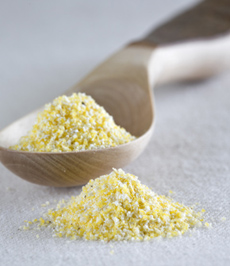TIP OF THE DAY: Cornmeal Instead Of Polenta
| If you read history or old literature, you encounter cornmeal. A flour ground from dried maize (corn), it’s been a staple for millennia, feeding the native populations of the Americas and, later, the Colonials. Ground to fine, medium and coarse consistencies, cornmeal is used to make everything from tortillas and cornbread to cookies and cakes. Like other flours, fine-ground cornmeal is also used to thicken sauces.
Polenta—the Italian word for cornmeal and a cooked dish made from it—has become popular in America through Italian and Continental restaurants. The introduction of polenta to American diets brought it back into the American kitchen, from which many decades ago it was replaced by refined wheat flour. But polenta is also refined: It is degerminated cornmeal, with the germ and endosperm removed. As with all refined grains, the protein, iron and vitamins are left on the factory floor. So what can you do if you love polenta? |

Cornmeal is a whole grain, unlike refined |
|
| Substitute stone ground whole grain cornmeal—no recipe adjustments needed to make polenta or any other recipe.
Be sure to read the package label, though: Some stone ground cornmeal is degerminated to extend its shelf life and is no longer a whole grain. (Store whole grains in the freezer if you don’t use them up.) You can find whole grain cornmeal from one of our favorite brands, Bob’s Red Mill, at natural food stores nationwide (including Whole Foods Markets). Substitute it for polenta in any recipe: to make cookies and cakes (nifty texture!), cornbread and corn muffins, hushpuppies and spoonbread. Old-fashioned cornmeal mush sounds great on this cold day, as we contemplate breakfast options. If you’re not near a store that sells cornmeal, check out the beautiful heirloom grain products at AnsonMills.com. If you love to cook and eat, be warned: You’ll probably want to order everything.
|
||


